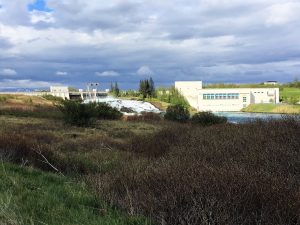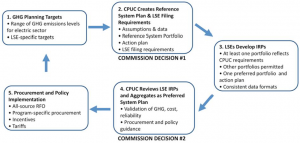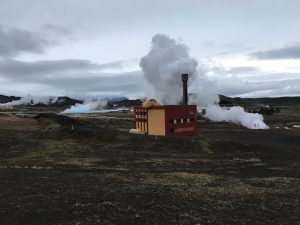One aspect of integrated resource planning is absolutely true: Utilities alone no longer determine the grid’s destiny.
Regulatory or Strategic IRP: A Pivotal Choice
How closely should a utility follow a commission-prescribed IRP process?
The utility had a clear problem: how to develop their current integrated resource plan (IRP). The size and scope of the problem seemed to expand daily.
The state’s public service commission had issued an order prescribing in detail the methodology and requirements necessary to be addressed in their IRP. The utility was used to creating their own IRP, with their own methodology, employing a tried-and-true process for attaining the goal of everyone’s IRP: reliable power at the lowest cost.
 But this current commission order turned all of that on its head.
But this current commission order turned all of that on its head.
Crossroad. What was being ordered looked more like an IRP that simply ticked off the commission’s boxes, and less like a strategic plan for delivering low-cost, reliable power. In fact, that traditional goal seemed to be secondary to the commission’s goal. Being one of the state’s largest and most visible utilities, its core executives realized that everyone was watching—and closely assessing—how they executed the commission’s directives. Thus, the executives were at a crossroad. They had to decide to develop their IRP by:
Scrupulously following commission guidelines (which on closer inspection, clearly had process-oriented holes) to satisfy regulatory requirements and other statutory goals.
Diligently relying on their tried-and-true methodology to satisfy their clear mission-oriented need to best serve their wide array of customer needs.
Far-reaching implications. They realized that their decision would have far reaching ramifications, some of which were most likely unknown, but certainly would be unearthed.
These utility executives were not delusional by any stretch. They were fully aware of the transformation that had been occurring in the electric power industry over the past several years. They fully understood that the familiar ground upon which the industry was based for the past one hundred or so years was completely in flux. They clearly understood how the inexorable influx of renewable generation, especially from distributed energy resources (DERs), coupled with drivers to reduce carbon emissions from greenhouse gases (GHGs), fundamentally changed their landscape.
And they embraced the fact that the planning process for developing their IRP had expanded in scope, incorporating both traditional and emerging factors: increasing numbers of inputs and assumptions; forecasting volatility; wider array of generation options; distribution planning; grid modernization; renewable generation targets (mostly through renewable portfolio standards—RPS—legislation); judicious thermal generation retirements; myriad financial considerations (capital expenditures, operation and maintenance expenses, and rate design being key); transportation electrification; emerging technologies; energy storage systems, both large-scale and distributed; and customer empowerment.
Even with all these additional consideration, the executives felt certain that their planning methodology could incorporate these factors and create a preferred portfolio of generation and distribution that satisfied their overarching need for reliable power at a low cost while still maintaining a level of adaptability to adjust to future known and unknown circumstances.
Ultimately, their collective eyes were open.
To come to grips with their basic IRP problem, they assembled a planning committee that included representatives and executives from resource planning, transmission and distribution, finance, operations, legal, regulatory, and corporate communication.
Paths for an IRP. The planning committee quickly honed in on their purpose: to choose a path that best served their customers. They assimilated all the information they had, considered what other utilities were planning and had actually done, considered their past experiences, considered their apparent place in the state’s utility mix, and projected the implications of their decision, then pinpointed three potential paths:
Adhere to the commission’s prescriptive path to the letter, essentially abdicating their contributions to developing an IRP.
Expand on their tried-and-true process to incorporate evolving changes in the energy landscape (including meeting statutory and regulatory requirements) and thus establish an updated process for developing an IRP.
Duplicate their work by developing two IRPs simultaneously: one that employed the commission’s prescriptive path; and one that traversed their own need for a strategic plan. Left unsolved for the moment, was the decision on which of these two IRPs to file.
Deciding on which path to choose is a question that many utilities are being forced to answer—an answer that has far-reaching and pivotal implications for everyone involved.
—Rich Maggiani, Resource Planning Consultant
Integrated Resource Planning Transformation Study & Report
What do utility resource planning managers and electric industry professionals have to say about the wholesale transformation that has been occurring in integrated resource planning over the past five years? Turns out, a lot.
 While a number of reports and studies evaluate and record this transformation, these managers and professionals live it—every day. They experience exactly how that transformation affects their daily work lives, and how integrated resource planning has become more complex, wider reaching, and increasingly difficult. We know. We interviewed over three dozen resource planning managers, resource planning analysts, utility executives, and industry consultants from across the country to understand and report on their daily struggles. From those interviews, we wrote The Integrated Resource Planning Transformation study and report.
While a number of reports and studies evaluate and record this transformation, these managers and professionals live it—every day. They experience exactly how that transformation affects their daily work lives, and how integrated resource planning has become more complex, wider reaching, and increasingly difficult. We know. We interviewed over three dozen resource planning managers, resource planning analysts, utility executives, and industry consultants from across the country to understand and report on their daily struggles. From those interviews, we wrote The Integrated Resource Planning Transformation study and report.
Through those interviews, we discovered that many disruptive catalysts converged to stimulate and energize this integrated resource planning transformation. The most prominent catalyst: the increasing influx of distributed energy resources (DERs) at the grid edge, especially from rooftop solar installations combined with their decreasing costs and statutory incentives. DERs, however, are far from the only disruption. A confluence of other catalysts undermines the integrated resource planning process:
Continue reading Integrated Resource Planning Transformation Study & Report
NEM Launched the Distributed Energy (R)Evolution
Net energy metering energized rooftop solar installations—and everything changed
Events in Nevada over the past three years shone a bright light on how net energy metering (NEM) has affected the evolution of distributed energy resources (DERs). Or would it be more accurate to call it the DER revolution?
Nevada: an insightful perspective. In December 2015, the Public Utilities Commission of Nevada (PUCN) cut NEM compensation by about one-third and instituted a monthly fixed charge. This new policy applied to both new and existing NEM installations, virtually all of which were rooftop solar photovoltaic (PV) panels.

This decision significantly decreased NEM compensation while it also extended the payback period for a rooftop system. The consequences were quick and monumental. Immediately, the top three solar installers in the state announced their intention of moving to more “business friendly” states. It came as no surprise when rooftop solar installations dropped 92% in first quarter 2016. Nevada, once a darling in the solar sector, became a virtual wasteland.
Until the PUCN reversed itself.
Continue reading NEM Launched the Distributed Energy (R)Evolution
The Hawaiian Plan: 100% Renewable Energy by 2045
A grid planning process strengthens Hawai‘i’s lead in developing a renewable energy grid
The Hawaiian Electric Companies have a plan. Their resource plan, filed in December 2016, outlines the near-term actions for attaining 100 percent renewable generation in their service area by the state’s mandated goal of 2045; the most ambitious—and only—such plan in the country.
In July 2017, the Hawai‘i Public Utilities Commission (HPUC) formally accepted this December-filed resource plan—their Power Supply Improvement Plan (PSIP), which was updated from a previous PSIP filed in April 2016.
 Broad, inclusive participation. Both PSIPs were created in an open, collaborative process that included multiple participants and intervenors admitted into the docket. These participants were directed to “propose questions and suggest alternative modeling inputs, assumptions, methods, and analytical approaches” that Company planners must consider to incorporate into the resource planning process.
Broad, inclusive participation. Both PSIPs were created in an open, collaborative process that included multiple participants and intervenors admitted into the docket. These participants were directed to “propose questions and suggest alternative modeling inputs, assumptions, methods, and analytical approaches” that Company planners must consider to incorporate into the resource planning process.
Selecting generation resources. Company planners ran production simulations using optimized candidate resource plans that incorporated distributed energy resources (DER), demand response programs, and other resources; then analyzed system security requirements to ensure system reliability. From the final results, they developed near-term (2017–2021) action plans that encompass renewable acquisitions, grid modernization, DER policies, environmental compliance, and system security improvements.
In the aggregate, these action plans add enough rooftop and feed-in tariff solar generation combined with large-scale solar and wind to attain a 52% RPS by 2021.
Continue reading The Hawaiian Plan: 100% Renewable Energy by 2045
A Statewide Approach to Integrated Resource Planning
Achieving a 40% reduction in greenhouse gas emissions by 2030 drives this California initiative
Creating an Integrated Resource Plan is a formidable challenge. I know; I’ve helped create and write several IRPs during the past decade that each followed a process developed 25 years ago. This is why the process currently being proposed by the California Public Utilities Commission (CPUC) staggers me.
Typically, IRPs created by a utility or a load serving entity (LSE) focus on providing reliable, affordable power for their service area and customers. While these IRPs comprise a wide range of generation, costs, transmission and distribution, and service, they are isolated plans.

The CPUC proposes to elevate all that. Its proposal involves an iterative process to compile individual IRPs into one statewide resource plan—in other words, a resource plan using the state as its service area. This process seeks to balance the individual loads, generation resources, planning perspectives, power grids, and other aspects of each LSE—large and small, public and private—into one cohesive direction that focuses energy generation in the state.
Senate Bill 350, which initiated the CPUC proposal, requires an IRP development process that meets California’s greenhouse gas (GHG) emission reduction targets. The upshot, however, requires a modernized grid to transmit increasing amounts of renewable energy. Among many other goals, SB 350 calls for 50% renewable generation by 2030, essentially doubling current output. The pending SB 100 ups the ante by requiring 60% renewable generation by 2030 and a non-mandatory 100% by 2045.
Continue reading A Statewide Approach to Integrated Resource Planning
California: Working to Elevate Integrated Resource Planning
Greenhouse gas emission reductions, cost, and reliability are the drivers
Regulatory officials in California are raising the bar on integrated resource planning, taking it to a more efficient and effective level.
The California Public Utilities Commission (CPUC), together with the California Energy Commission (CEC), is guiding a process that helps each load-serving entity (LSE) collectively meet statewide energy, social, and environmental goals.
 CPUC staff have issued a proposal for implementing integrated resource planning across the state. This proposal, created with input from the LSEs, outlines a structured process for LSEs to develop IRPs and for the CPUC to review these IRPs. The CEC has also drafted IRP submission and review guidelines specifically for publicly owned utilities. These proposals must first by adopted by the Commissioners before taking effect.
CPUC staff have issued a proposal for implementing integrated resource planning across the state. This proposal, created with input from the LSEs, outlines a structured process for LSEs to develop IRPs and for the CPUC to review these IRPs. The CEC has also drafted IRP submission and review guidelines specifically for publicly owned utilities. These proposals must first by adopted by the Commissioners before taking effect.
How is the California IRP process different? From its very foundation, the IRP process being developed in California lays a stronger foundation than those employed by virtually any other state. Here are eight such building blocks:
- The IRP process uses greenhouse gas (GHG) emission reductions, cost, and reliability as drivers for deriving the amount of renewable energy in the resultant generation mix.
Continue reading California: Working to Elevate Integrated Resource Planning
Net Energy Metering: An Honest Story
An actual conversation I had recently at a business organization meeting
He took my arm firmly, pulling me aside for a private conversation. I had been standing in a small circle with colleagues, talking, at a business organization meeting when he accosted me.
“So,” he started. “I understand you work with electric utilities.” More of a question than a statement.
It all happened so suddenly that I just looked at him. “Have we met?” I asked, mainly to gather myself.
 “No,” he said, then introduced himself. I returned the favor.
“No,” he said, then introduced himself. I returned the favor.
“I know who you are,” he continued. “You used to sit on an energy-related committee with my wife.”
“And she is…” I ventured.
He told me. Different last name. But now I understood the connection. They modernized older properties, and one of their initiatives is to lower the energy requirements of the buildings by integrating renewable resources and energy efficiency measures.
“Ah. Yes, I work with electric utilities.”
“Around renewable energy?”
“Mainly around integrating more renewable resources into the electric grid.”
“So you know a lot about rooftop solar photovoltaic panels?”
Social Media as Chaos
I have a social media habit. But it’s not the kind of habit you might think. It doesn’t encompass my every waking hour. I engage once in the morning and then pretty much leave it alone after that. Here’s what I generally do every day.
First, I start with Facebook. I scroll through to find anything interesting, especially posts from my three kids. Then I check out LinkedIn. Who’s invited me to connect? Who’s endorsed me? Who’s looked at my profile? I check out an article or a random post.
 I don’t muck much with Twitter except to search on #stcorg and #stc13 . After looking at these two searches, I usually just close it. I might check out Instagram, but usually only because one of my children has posted there. Next, I check out the ST C Board of Directors site to read any new posts. And I check my iPhone to see if there is any pushed content I find interesting.
I don’t muck much with Twitter except to search on #stcorg and #stc13 . After looking at these two searches, I usually just close it. I might check out Instagram, but usually only because one of my children has posted there. Next, I check out the ST C Board of Directors site to read any new posts. And I check my iPhone to see if there is any pushed content I find interesting.
One morning, though, things were particularly active. I kept getting new posts all over the place. Bing here, ping there, bop over there. (Ok, not audibly; metaphorically, but you get the idea.) I could barely keep up. For some reason that I didn’t totally fathom, I wanted to check them all out. It quickly became took much, moving back and forth, forth and back, that it all became, well … chaotic!
When that thought hit me, it just brought everything to a halt. Is social media just chaos, and we’ve all been sucked in to the flurry? While my computer and smart phone kept pinging and popping, I began to wonder. What if social media is a manifestation of the chaos theory? Well, that just might explain a lot.
A Communication Audit Helps You Communicate Better
Whether you are growing, changing, or introducing new business technologies, a communication audit is helpful, if not essential
A Communication Audit. This is a comprehensive, systematic evaluation and analysis of your company’s communication. A communication audit unveils what is  truly happening as opposed to what is thought to be happening. It:
truly happening as opposed to what is thought to be happening. It:
- Encompasses the activities conducted in a communication assessment and its resultant findings (although here it is more robust).
- Identifies the people who create the messages and information being communicated.
- Evaluates the clarity and value of the communication.
- Critically looks at the various methods of communication (such as Web sites, newsletters, emails, blogs, videos, and other publications, as well as interpersonal skills and managerial communication), pinpointing problem areas and identifying successes.
A communication audit must be thoughtfully planned and implemented, and the results carefully assessed to achieve the greatest impact.
The Scope of a Communication Audit. You can focus on a number of communication areas to evaluate and analyze. This focus can be the broad-based communication for the entire company or for an individual division or group. It can be a specific communication method (such as interpersonal communication or your internal Web site) or for a specific vehicle (such as your corporate publications).
Continue reading A Communication Audit Helps You Communicate Better